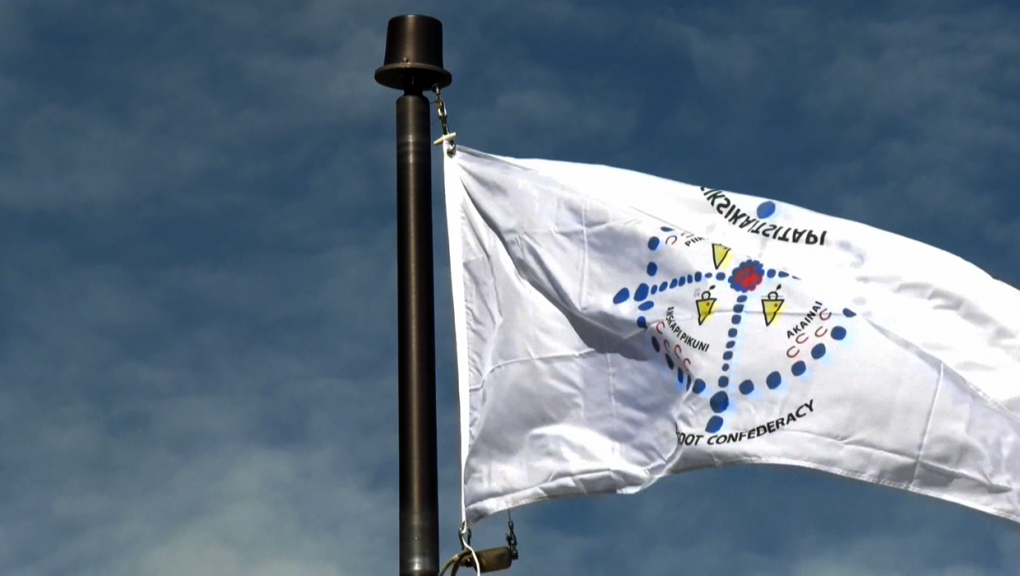The City of Lethbridge looking for feedback on public space naming
 The Blackfoot Confederacy Flag was raised at Lethbridge city hall to kick off National Indigenous Peoples Week in June, 2020. The City is currently seeking input into how to incorporate Indigenous culture with its placemaking project.
The Blackfoot Confederacy Flag was raised at Lethbridge city hall to kick off National Indigenous Peoples Week in June, 2020. The City is currently seeking input into how to incorporate Indigenous culture with its placemaking project.
The City of Lethbridge is asking residents for feedback on the ways Indigenous people are represented through its evolving placemaking strategy.
The strategy has been in place since May of 2021 in response to the Truth and Reconciliation, and to represent the Blackfoot community and other Indigenous through their culture, language, art, and heritage interpretation.
Council have been working together with the Indigenous community’s representation looking for ways to bring Indigenous culture to life within Lethbridge.
“We’ve been working directly with the Blackfoot confederacy nations through elders and consulted youth to understand their perspective on existing name places throughout their community,"said Perry Stein the Indigenous relations advisor in a news conference earlier Tuesday. "And also working to do broader public engagement to understand the perspective of residents and visitors to Lethbridge on how they understand the impact in the level of inclusion in existing names and places throughout the city.”
The survey together with Indigenous partners feedback will be put together with a list of recommendations and will be presented at the city council in either April or May.
It will also help the city council in decision making when naming public spaces.
The survey is open to the public and will be closed Feb.28.
CTVNews.ca Top Stories

BREAKING Police to announce arrests in Toronto Pearson airport gold heist
Police say that arrests have been made in connection with a $20-million gold heist at Toronto Pearson International Airport one year ago.
Outdated cancer screening guidelines jeopardizing early detection, doctors say
A group of doctors say Canadian cancer screening guidelines set by a national task force are out-of-date and putting people at risk because their cancers aren't detected early enough.
Lululemon unveils first summer kit for Canada's Olympic and Paralympic teams
Lululemon says it is combining function and fashion in its first-ever summer kit for Canada's Olympians and Paralympians.
Canada's health-care crisis was 'decades in the making,' says CMA
The strain placed on Canadian health care during the COVID-19 pandemic shows no sign of abating, and the top official of the Canadian Medical Association (CMA) is warning that improving the system will be a 'slow process' requiring sustained investment.
'I just started crying': Blue Jays player signs jersey for man in hospital
An Ontario woman says she never expected to be gifted a Blue Jays jersey for her ailing husband when she sat alone at the team’s home opener next to a couple of kind strangers.
Mussolini's wartime bunker opens to the public in Rome
After its last closure in 2021, it has now reopened for guided tours of the air raid shelter and the bunker. The complex now includes a multimedia exhibition about Rome during World War II, air raid systems for civilians, and the series of 51 Allied bombings that pummeled the city between July 1943 and May 1944.
LIVE @ 4 EDT Freeland to present 2024 federal budget, promising billions in new spending
Canadians will learn Tuesday the entirety of the federal Liberal government's new spending plans, and how they intend to pay for them, when Deputy Prime Minister and Finance Minister Chrystia Freeland tables the 2024 federal budget.
B.C. woman facing steep medical bills, uncertain future after Thailand crash
The family of a Victoria, B.C., woman who was seriously injured in an accident in Thailand is pleading for help as medical bills pile up.
Step inside 'The Brain': Northern education tool aims to promote drug safety
An immersive experience inside a massive dome coined 'The Brain' is helping youth learn about brain function and addiction
































